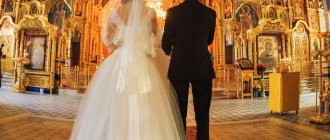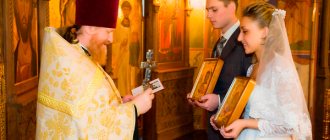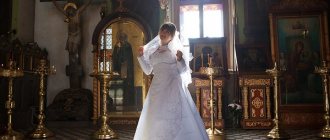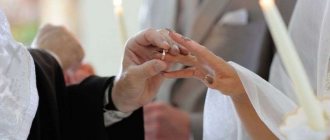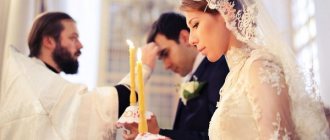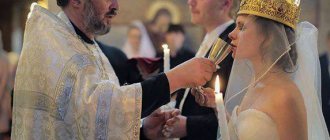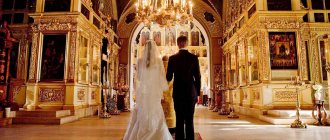The spiritual essence of a wedding
Jesus in the Bible said that people cannot destroy a union blessed by God. (Matthew 19:4-8).
The wedding ceremony in the Orthodox Church is an action performed by priests as intermediaries between God and people, during which two souls merge into one.
Genesis 1:27 says that God created man, notice, not two people, but one - the Lord created male and female.
The sacrament of a couple coming down the aisle consists of calling on the help of the Holy Trinity to give a blessing for their future family life.
During the blessing ceremony, the couple comes under the spiritual protection of the Church, becoming a part of It.
The head of the family is the husband, and to him is Jesus.
The married couple is a prototype of the relationship between Jesus and the Church, where Christ is the groom, and the Church is the bride, awaiting the arrival of His betrothed.
In a small church-family, services also take place in the form of general prayers and reading the Word of God, and the spouses make their own sacrifices for obedience, patience, submission and other Christian sacrifices.
About family life in Orthodoxy:
- What is an Orthodox family
- Responsibilities and Instructions for Husband and Wife
- Married life during Lent
Children born to an Orthodox couple are given a special blessing at birth.
Starting a common life, even if Christians are not true doers of the Word of God and rarely attend temple services, they can come to God through the Sacrament of uniting two into one.
Only by standing under the crown of God's blessing can one feel the power of His grace.
Sometimes a couple is in love with each other only on a physical level, but this is not enough to build a happy life together.
After the rite of spiritual union, a special connection appears, giving a strong impetus for a long-lasting marriage.
Receiving blessings in the temple, the couple trusts themselves to the protection of the Church, letting Jesus Christ into their life as the Lord of the house.
After the perfect ceremony, God takes marriage into His hands and carries it through life, but subject to the observance of Christian laws by family members and chastity.
Wedding
Wedding
Engagement is followed by wedding.
The bride and groom, holding lighted candles in their hands, symbolizing the spiritual light of the Sacrament, solemnly walk to the middle of the temple. They are preceded by a priest with a censer, indicating that on the path of life they must follow the commandments of the Lord, and their good deeds will ascend to God like incense. The bride and groom stand in front of the lectern on a cloth (white or pink) spread on the floor. On the analogue lie a cross, a Gospel and crowns. The bride and groom, in the face of the entire Church, once again confirm the free and spontaneous desire to get married and the absence in the past of each of them of a promise to a third party to marry him. “Do you have a sincere and spontaneous desire and firm intention to be the husband of this (name of the bride) whom you see here before you?” asks the priest, and the groom replies: “I have, honest father.” - “Aren’t you bound by a promise to another bride?” - “No, not connected.” Then, turning to the bride, the priest asks: “Do you have a sincere and spontaneous desire and firm intention to be the wife of this (name of the groom) whom you see in front of you?” - “I have, honest father.” “Aren’t you bound by a promise to another groom?” - “No, not connected.” So, the bride and groom confirmed before God and the Church the voluntariness and inviolability of their intention to enter into marriage. And only now begins the mysterious sanctification of marriage by Divine grace - the Sacrament of Wedding. The priest says three prayers in which he asks the Lord to bless the marriage and send His heavenly grace to those entering into it. The first prayer is addressed to the Lord Jesus Christ. The priest prays: “Bless this marriage: and give to Your servants a peaceful life, long life, love for each other in a union of peace, a long-living seed and an unfading crown of glory; make them worthy to see the children of their children, keep their bed unblamed. And grant them from the dew of heaven from above, and from the fatness of the earth; Fill their houses with wheat, wine and oil, and every good thing so that they share the excess with those in need, and grant to those who are now with us everything necessary for salvation.” In the second prayer, the priest prays to the Triune Lord to bless, protect and remember the newlyweds. “Granting to them the fruit of the womb, good children, like-mindedness in their souls, exalt them like the cedars of Lebanon, like a vine with beautiful branches, give them spiked seed, so that they, having contentment in everything, may abound for every good work that is pleasing to You. And may they see sons from their sons, like the young shoots of an olive tree, around their trunk, and having pleased You, may they shine like lights in the sky in You, our Lord.” Then, in the third prayer, the priest once again turns to the Triune God and begs Him, so that He, who created man and then from his rib created a wife to help him, would now send down His hand from His holy dwelling, and unite the spouses, crown them into one flesh, and gave them the fruit of the womb. After these prayers, the most important minutes of the Wedding begin. What the priest prayed to the Lord God for in the face of the whole church and together with the whole church - for the blessing of God - is now apparently being accomplished over the newlyweds, strengthening and sanctifying their marital union. The priest, taking the crown, marks the groom with a cross and gives him to kiss the image of the Savior attached to the front of the crown. When crowning the groom, the priest says: “The servant of God (name) is being married to the servant of God (name of the bride) in the name of the Father, and the Son, and the Holy Spirit.” Having blessed the bride in the same way and allowing her to venerate the image of the Most Holy Mother of God that adorns her crown, the priest crowns her, saying: “The servant of God (name) is married to the servant of God (name of the groom) in the name of the Father, and the Son, and the Holy Spirit.” . Decorated with crowns, the bride and groom stand before the face of God Himself, the face of the entire Heavenly and Earthly Church and await God's blessing. The most solemn, holiest moment of the wedding is coming! The priest, raising his hands to God, says three times: “Lord our God, crown them with glory and honor!” With these words, he, on behalf of God, blesses them. The priest pronounces this prayerful exclamation three times and blesses the bride and groom three times. All those present in the temple should strengthen the prayer of the priest, in the depths of their souls they should repeat after him: “Lord, our God! Crown them with glory and honor!” The laying of crowns and the words of the priest: “Our Lord, crown them with glory and honor” - seal the Sacrament of Marriage. From this moment on, the groom is already the husband of his bride, and the bride is the wife of her groom. From this moment on, husband and wife are bound by indissoluble bonds of marriage, for “What God has joined together, let no man separate.”
Then the Apostle and the Gospel are read, speaking about the meaning of marriage and the Savior’s blessing of marriage in Cana of Galilee.
The last saying of the apostle: “This mystery is great; I speak in relation to Christ and to the Church. So let each of you love his wife as himself; but let the wife be afraid of her husband.”
“This message, on the one hand, speaks of a very deep relationship between the Church and Christ,” writes Metropolitan Anthony of Sourozh, “Christ came to earth to save humanity; God became man, and He accomplishes this salvation at the cost of His life and His death. And this is the first thing husbands should think about when they get married: they are given by God a fragile creature to whom they said: “I love you,” and this love should be such that the husband is ready to sacrifice everything, all of his life, for the love of his wife and for the love of his children. The husband is the head of the family not because he is a man, but because he is the image of Christ, and his wife and children can see this image in him, that is, the image of boundless love, devoted love, self-sacrificing love, love that is ready to do anything to save, protect, nourish, console, delight, and raise your family. Every person should remember this. It is too easy for a man to think that just because he is a man, he has rights over his wife, over his wife and over his children. It is not true. If he is not the image of Christ, then no one owes him any respect, no fear, no obedience. And the wife is an icon, an image of the Church. The Church has, as it were, two faces. She is a bride, rejoicing that she is loved by God, and loved with such love as is revealed in Christ. But at the same time (and this is the image that the Apostle Paul gives in one of his epistles) she is the bride of the Lamb, that is, the slain Savior. She is the bride, the one who so deeply, so completely loved her fiancé that, out of unshakable fidelity, she can leave everything, forget everything, break away from everything out of love for him and follow him wherever he goes, if necessary - even to suffering, if necessary - to the cross. You see that this message is not talking about the dominion of the husband and the subordination of the wife, but about the kind of mutual love that is the sacrificial, heroic love of the husband, and to which the wife can respond with the same sacrificial love. We must always remember this, because too often this passage of Holy Scripture is interpreted falsely: humiliating the wife and exalting the husband, presenting him as a proud ruler.” Then a cup of red wine (the cup of communion) is brought, and the priest blesses it for the mutual communion of husband and wife. Wine at a wedding is served as a sign of joy and fun, reminiscent of the miraculous transformation of water into wine performed by Jesus Christ in Cana of Galilee. As a sign that husband and wife should share each other’s joys and sufferings, those getting married drink wine from a common cup - symbolizing life’s cup of joys and sorrows, which the spouses must share until the end of their days. Usually the wine is taken in three small sips: first the husband, as the head of the family, then the wife. Having presented the common cup, the priest connects the right hand of the husband with the right hand of the wife, covers their hands with the stole and places his hand on top of it. This means that through the hand of the priest the husband receives a wife from the Church itself, uniting them in Christ forever. The priest leads the newlyweds around the lectern three times while the wedding troparions are sung. The choir accompanies each circle with a special chant. The first speaks of the incarnation of the Son of God from the Virgin Mary, in the second the Church asks the prayers of the holy martyrs so that the newlyweds will go through the difficult path of family life, and, despite the difficulties, will not waver in fulfilling the commandments of the Lord. Finally, the third hymn gives glory to God, Who is “the praise of the apostles, the joy of martyrs.” This circular walk of the wedding couple around the lectern means the eternal procession hand in hand, which began on this day for this couple and will be the continuation and manifestation of the sacrament performed today. Remembering the common cross laid upon them today, “bearing each other’s burdens,” they will always be filled with the gracious joy of this day. At the end of the solemn procession, the priest removes the crowns from the spouses and reads two final prayers, asking the new family for heavenly and earthly blessings. He asks the Lord, who blessed the marriage in Cana of Gailee, to accept the crowns of the newlyweds undefiled and undefiled in His Kingdom. In the second prayer, read by the priest, with the newlyweds bowing their heads, these petitions are imprinted with the name of the Most Holy Trinity and the priestly blessing. At the end of it, the newlyweds testify to their holy and pure love for each other with a chaste kiss. Further, according to custom, the newlyweds are led to the royal doors, where the groom kisses the icon of the Savior, and the bride kisses the image of the Mother of God; then they change places and are applied accordingly: the groom - to the icon of the Mother of God, and the bride - to the icon of the Savior.
At the end of the sacrament, the priest pronounces a word of edification to the spouses, gives them a cross to kiss and hands them two icons: to the groom - the image of the Savior, to the bride - the image of the Most Holy Theotokos.
Then the new Christian family is congratulated by family and friends.
What is the spiritual process of preparing for a wedding?
The wedding rules in the Orthodox Church state that one should prepare for an important event in spiritual life. Govenye is a Christian feat of the future family before the Holy Church.
Without confession and communion of the Holy Mysteries, a couple cannot be admitted to the ceremony of blessing before God.
Following all the recommendations for preparing for confession, both the bride and groom should pray intensely and ask God:
- show all sins, explicit and implicit, and forgive them;
- let go of all those who offend from your heart;
- ask forgiveness from those offended;
- pay off debts.
After confession, the couple is allowed to receive communion.
How to write a wedding vow, practical advice
You can write a bewitching text that will contain real feelings for each other yourself or order it from a professional . There is also an option to copy the oath from the Internet. It is advisable to compose your own speech for the wedding, since this is a very intimate moment, everything should come from the heart. But you can still find inspiration on the World Wide Web.
The following points can inspire you to write a beautiful wedding oath:
- Your acquaintance with your soulmate - what emotions were there, what interesting things happened.
- Touching moments of your love story. Anything unforgettable and romantic can become inspiration.
- Character traits for which you fell in love with your soulmate. You can talk about what attracts and makes you proud.
- Your joint plans for the future. Talk about your dreams and desires, and vow to achieve them no matter what. These could be plans for a new home, travel, a desire to have children, get a dog, etc.
Tips for the bride on how to write a wedding vow
Women are particularly emotional and romantic. Therefore, their vows can be written in one go and take up an entire notebook. But you need to approach this issue rationally.
The wedding ceremony time is limited. In addition, speaking too long can bore guests. Everything should be in moderation. It’s better to write down everything you want to say in advance and estimate the size of the text. If there is too much, try to cut it down, leaving the most important thing. The optimal version of the oath lasts about 1-2 minutes.
What to buy before the wedding
There is a whole list of items needed to perform the ritual.
- Wedding icons are an important attribute when blessing a couple. In the future, the Holy images of the Mother of God and Jesus Christ will become a talisman and blessing shrines for the family.
- Wedding rings have no edge or end. By putting the ring on each other, the bride and groom swear eternal love and the indissolubility of their consecrated marriage.
Gold rings are symbols of the sun's radiance, silver rings are a reflection of the moonlight, which shines in the reflection of the sun.
So the Orthodox family shines in the reflection of the love of God's Trinity.
- Candles for weddings.
- Handkerchiefs to hold candles and crowns.
- Embroidered towels or boards that: decorate icons;
- cover a tray with a loaf of bread;
- placed under your feet.
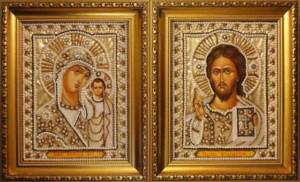
Wedding icon
Engagement
In the temple, the groom stands on the right and the bride on the left. The priest blesses first the groom, then the bride, three times, saying: “In the name of the Father, and the Son, and the Holy Spirit” and gives them lighted candles. For each blessing, first the groom, then the bride, make the sign of the cross three times and receive candles from the priest.
The lit candles held in the hands of the bride and groom signify the joy and love that they have for each other and which should always be fiery and pure. Lighted candles also signify the chastity of the bride and groom and the grace of God that rests on them.
After this, the priest takes the rings from the holy altar and first puts the ring on the groom, making the sign of the cross three times, saying: “The servant of God (name of the groom) is betrothed to the servant of God (name of the bride) in the name of the Father, and the Son, and the Holy Spirit.”
Then he puts a ring on the bride, also overshadowing her three times, and says the words: “The servant of God (the name of the bride) is betrothed to the servant of God (the name of the groom) in the name of the Father, and the Son, and the Holy Spirit.”
When engaged, rings are very important: they are not just a gift from the groom to his bride, but a sign of an inextricable, eternal union between them. Before the betrothal ceremony, the priest places the rings on the right side of the Holy Throne, as if in front of the face of the Lord Jesus Christ Himself. This emphasizes that by touching the Holy Throne and being on it, the rings receive the power of consecration and subsequently bring down the blessing of God on the couple. The rings on the Holy Altar lie side by side, thereby expressing the mutual love and unity in faith of the bride and groom. After the priest's blessing, the bride and groom exchange rings. The groom puts his ring on the bride’s hand as a sign of love and readiness to sacrifice everything for his wife and help her all her life; the bride puts her ring on the groom's hand as a sign of her love and devotion, as a sign of her readiness to accept help from him throughout her life. Such an exchange is carried out three times in honor and glory of the Most Holy Trinity, which accomplishes and approves everything (often the priest himself changes the rings). Then the priest again prays to the Lord that He Himself would bless and approve the betrothal, that He would overshadow the position of the rings with a heavenly blessing and send the bride and groom a guardian angel and guide in their new life. This is where the engagement ends.
Is the presence of witnesses mandatory?
Before the revolution, marriage took place only in the temple and had all civil and legal rights.
Orthodox weddings took place only in the presence of guarantors, current witnesses who were recorded in church books as recipients.
As a rule, people who knew the families of the bride and groom were taken as witnesses. The guarantors not only confirmed the completed Sacrament with their signatures, but later became trustees of the young couple.
At that time, unmarried, young people who themselves did not yet know the complexities of family life were not taken as witnesses. When church records disappeared, these people acted as witnesses to the completed Sacrament.
Nowadays, the church does not require the obligatory presence of witnesses at marriages, but welcomes when relatives, friends and relatives come to share the Sacrament with the newlyweds.
Witnesses, Orthodox Christians, hold crowns over the heads of the couple.
The bride or witness must take care of snow-white festive scarves in advance for this action.
In the absence of guarantors, the crowns are placed on the heads of those getting married, so the young woman prudently makes a hairstyle that will not interfere with the reclining of the crown.
Is it possible for an Orthodox Christian who does not strictly adhere to church canons to get married?
Some people have turned the ceremony of marriage in a temple into a fashionable attribute of a wedding, treating it without any reverence.
Not understanding the spiritual value of the blessing of a future common life, people deprive themselves of the spiritual joy of being under the protection of the Almighty.
Some young people refuse blessings in the temple due to a cooling of faith.
The Creator opens his doors to all Orthodox Christians who want to receive the sanctification of their marriage. No one knows at what time the Holy Spirit will touch the heart of a sinner; perhaps it will happen during the wedding. There is no need to limit God in giving mercy.
Mandatory fasting and communion will help the bride and groom approach the throne of God with reverence.
Prayers for the family:
- Prayers for peace in the family
- Prayers of Blessed Ksenia of Petersburg for family well-being
- Prayers to the martyrs Guria, Samon and Aviv
What prayer should you read on your wedding anniversary?
Years fly by like moments, you don’t have time to look back, but the first wedding day is long behind you and a new countdown begins - wedding anniversaries. In Russian folklore, there are many traditions, rituals and signs that accompany the anniversary of a life lived together. The very first holiday for newlyweds is a green wedding, it begins its countdown from the day of the wedding and is celebrated monthly on the date when the marriage was registered. The symbol of this holiday is fresh flowers, which the newlyweds exchange.
The first anniversary of marriage is a chintz or gauze wedding - on this day the spouses give each other colorful chintz handkerchiefs, not forgetting to give the same handkerchiefs to the guests invited to the celebration. The brighter the scarves, the brighter their future life will be.
The second anniversary of marriage is a paper wedding, on this day the spouses exchange paper products - paintings, postcards, and the like. It’s good to carry out a special ritual: to do this, you need to make a list of all the unpleasant moments over the past two years and burn it with joy and pleasure.
Third anniversary - leather wedding, spouses exchange leather goods. A good omen would be to give your spouse a leather wallet with a coin in it - the main breadwinner in the family will always have money, and the wife - a belt, a symbol that she will always be able to keep her husband.
The fourth anniversary is a wax wedding, on this day you need to light as many candles as possible in the house, it is better not to invite guests on this day, but to spend time together. You should give each other candles as a gift, preferably red.
The fifth anniversary is a wooden wedding, on this day the spouses exchange wood products. It’s good to burn a ritual log on this day, in which you need to hollow out a hole and put a leaf in it, with desire. which should be mutual. Make sure that the log burns completely and scatter the ashes from the log on the river. or any other body of water.
Sixth anniversary - cast iron wedding, the husband gives his wife a cast iron frying pan or pot, in which she must cook something on the same day, slightly salting the food.
Six and a half years is a zinc wedding, on this day zinc products are given as gifts: a basin, a bathtub.
Seven years of marriage - copper wedding, on this day the spouses exchange gifts made of copper, but subsequently you need to strictly ensure that these gifts do not darken. It’s good to give each other a piggy bank with copper coins.
The eighth anniversary is a tin wedding; on this day it is customary to give kitchen utensils made of tin. but always with something soft and fluffy. For example, a baking tray, and put a soft toy on it.
The ninth anniversary is a faience wedding, on this day you need to give each other earthenware sets, it’s good to plant two plants at home on this day, in earthenware pots respectively - myrtle and money tree.
Tenth anniversary - tin or rose wedding, choose a gift of your choice: roses or tin items. If you chose roses, then after the flowers fade, collect the petals, sew them into a white cotton bag and keep them at home - these petals will be a talisman for your marriage.
The eleventh anniversary is a steel wedding. On this day, steel products are given, but sharp objects cannot be given - knives, forks and the like.
Twelve and a half years is a nickel wedding, brilliant gifts are given on this day, no guests are invited, it’s good to walk together under the stars on this day and make a wish while looking at the sky.
Thirteen years - lily of the valley or lace wedding, on this day gifts are given that correspond to the name.
Fourteen years - agate wedding, on this day it is good to give jewelry with agate, on this day they invite their parents to their place, making sure to prepare gifts for them.
Fifteenth birthday - crystal wedding, on this day they give crystal, but you cannot give mirrors. Make sure that nothing breaks on this day, especially gifts.
Eighteen years - turquoise wedding, on this day items with turquoise are given, blue colors should predominate in clothes at the celebration, and the table should be well decorated with forget-me-nots.
Twenty years is a porcelain wedding, on this day they give porcelain, those dishes should be on the table. which was presented on this day. If something breaks, it’s a good sign; the fragments need to be collected and buried away from the house.
Twenty-five years of marriage - a silver wedding, on this day the spouses exchange silver rings, which they subsequently wear together with gold ones, putting on the gold ones first. Make sure that the silver donated on this day does not darken - a bad sign.
Thirty years of marriage - a pearl wedding, invited guests give the spouses items with pearls, but the spouses, contrary to the prevailing rule, cannot exchange such gifts, otherwise they will spend the rest of their life together in tears.
Thirty-four years - an amber wedding, as a gift - products with amber, it is good to make a ritual sacrifice to water on this day, to do this, just take a few coins, glass beads and throw them into the river, asking it for longevity and happiness.
Thirty-five years of marriage - linen, linen or coral wedding, gifts on this day should correspond to the name. The festive table must be covered with a white tablecloth.
Thirty-seven and a half years - aluminum wedding, it is better to serve the festive table with aluminum cutlery and gifts accordingly, but you cannot give a mug made of this metal - a bad sign.
Forty years is a ruby wedding, on this day the husband should give his wife earrings with a ruby, and she should give him something red.
Forty-five years of marriage - a sapphire wedding and appropriate gifts.
Forty-six years - lavender wedding, the best gift would be a bouquet of lavender.
Forty-seven years of marriage - a cashmere wedding.
Forty-eight years - an amethyst wedding.
Forty-nine years of marriage - a cedar wedding.
Fiftieth anniversary is a golden wedding. On this day, spouses exchange new gold rings. and the old ones give theirs to their grandchildren. who have not yet gotten married.
Fifty-five years - emerald wedding.
Sixty years - diamond wedding.
Sixty-five years - an iron wedding.
Sixty-seven and a half years - stone wedding.
The family is like a small world created by the voluntary union of two halves before God and people. And it depends only on these two how ready this marital world is to withstand life’s adversities. Let us remind you that it is very easy to destroy family happiness, but to preserve it, on the contrary, is not an easy task. Therefore, do not forget about prayer. It is never too late to ask for help from God and his Saints.
Prayer for the family will help preserve it, strengthen the spiritual foundation, and give strength and faith in love.
The family, as blessed by the community, grows in the communion of the husband and wife with God and this is its great strength.

Depending on the reason for turning to God, the following types can be distinguished:
- Prayer for well-being in the family;
- Prayer for family to the Mother of God;
- Marital prayer;
- Prayer for the preservation of the family.

Prayers to the saints that married couples look after can also be included in a separate category. First of all, let us pay attention to such a holy married couple as Peter and Fevronia. The patronage of Peter and Fevronia will help to overcome not only difficulties in family life, but also to find well-being and maintain trust.
When addressing Peter and Fevronia, the spouses should say a prayer together. You can hold hands so that their connection is strong and strong. Prayer to Peter and Fevronia is based on harmony and sincerity of feelings. If the spouses have disagreements, then a frank appeal to Saints Peter and Fevronia will certainly help to find strength to overcome the coming family crisis.
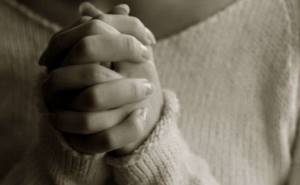
You can pray to Peter and Fevronia like this: “O great saints of God, faithful prince and princess, guardians of an honest marriage and love between spouses. Holy miracle workers, accept our prayers and show us how to preserve love and fidelity in our hearts. We pray to Peter to give him strength to protect his wife and children from all kinds of evil and troubles. We pray to Fevronia that she will give her wife wisdom and patience in marriage, and that she will always protect her children from illness and pain. Holy saints, take care of our union in heaven, and we will glorify you on earth.
In addition to paired family prayers, priests recommend praying individually. This is normal for a married couple, because prayer is always an intimate thing and, alone with their thoughts, each partner can ask the Lord or resort to the Mother of God for favors for the other. And this does not make their union weaker in the face of God, quite the contrary.
Let us consider separately the prayer for the wife and for the husband.
- Husband's prayer. Heavenly Our Father, You said in paradise, it is not good for a person to live on his own. You created and gave him a helper - the first woman, the foremother of the human race - Eve. By Your will, I have chosen a wife to serve You on earth. Give me the grace to be a good husband to the friend of my life that You gave me during my marriage. Help me to love her sincerely and to death, do not allow me to ever voluntarily cause trouble or offend her. Help me control myself and my passions, so that our bonds will be holy and dear to You. Give me the wisdom to understand her imperfections, give me the strength to work for our common good, so that my wife has everything that a good man should give to his wife, so that we serve You with one heart and one soul forever and ever. Amen.
- Wife's prayer. Almighty, help me to be a worthy wife to the man with whom you yourself united me in the Mystery of Marriage. I want to be a good wife and always please my husband in those things that please you. Make sure that in daily problems and disagreements with my husband, my love for him only grows stronger, is impenetrable and solid as a rock. Give me the wisdom to understand his needs, shortcomings and imperfections, and calmly bear the burden of family life. Keep me from the evil spirit that spoils married life, give me the grace to be a good wife, mother and housewife, so that because of me it will be easier for a man to glorify You. Mother of God, You were a model wife, give me the grace to inherit You in my marriage, to love my husband sincerely and faithfully until death. Amen.

We advise all married couples, before starting a quarrel and saying a bunch of painful words of reproach to each other - think about why you need this? You are together with your loved one, and, therefore, this time for two can be filled either with quarrels and accusations, or constructive, even if a certain problem has arisen. You are in this together, even if your partner has done (or often does) something you don’t really like. And if it’s really difficult, pray together. By praying to the Mother of God and the Lord our God together, you will feel peace and spiritual connection with each other. Always helps!
Since ancient times, it was customary in our country to receive a blessing with icons before the wedding for a long and happy life. This ritual is considered the most significant and exciting for both newlyweds and their parents.
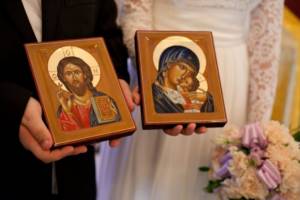
It is worth noting that, in principle, the tradition of blessing has been slightly different since those times. If in those days blessings were asked from parents long before the wedding, today blessings of parents take place at the wedding.
Despite the fact that modern young people themselves decide who and when they want to marry, the ceremony of blessing remains a rather important and touching moment of the entire wedding. This is probably right, because nothing can cheer you up and give confident guidance for your future life like the kind and sincere words of your parents.
The blessing ceremony can be performed in two ways:
- Orthodox. It follows certain rules. In this ritual, if one of the participants (parents or young people) is not baptized, then you must first cross yourself, and only then carry out the blessing. There must also be icons here. We will look at what icons are used for these purposes below. The whole ritual takes place with the help of icons. But still, in order to conduct the ceremony accurately and correctly, you need to clarify all the nuances with the priest the day before.
- Modern. This type of blessing is used quite often at modern weddings. It is used by young people who are not ready for a serious ceremony, and it has a purely formal look. It can also be performed by non-baptized people. To carry out the ceremony, it is enough to simply ask the parents to prepare a parting speech in advance.
Today, the icon of the Mother of God of Kazan and Christ the Savior is most often used to bless the young. Let's take a closer look at the icons for wedding blessings:
Today you can bless with both icons or with one of them. You can also buy a fold of these images in the icon shop.
The blessing of the daughter is carried out with the help of the face of the Kazan Mother of God. The father must give the icons to the mother. Moreover, it is very important that the mother holds towels, because it is not customary to take holy images with bare hands. The father holds a loaf of bread during the ceremony.
Parents take turns saying their wishes without interrupting each other. The parting words should be succinct, concise and simple. After pronouncing the speech, the daughter must be crossed three times and the image brought to her. She must also cross the image and kiss it. If the young woman does not have parents, then the ceremony can be performed by godparents.
- The groom's father holds the icon, the young mother holds the loaf.
- Mothers of young people hold icons, and fathers hold champagne and a loaf of bread,
- One of the mothers holds images of saints, the other a loaf, and the fathers simply stand on the sides.
All diagrams should be viewed from left to right. You can use a special prayer during the ceremony. It is pronounced before the wishes of the parents themselves. If it is better not to memorize the wish, so as not to forget during excitement, then you should try to learn the prayer.
Lord Jesus Christ, Son of God, prayers for the sake of Thy Most Pure Mother, hear me, Thy sinful and unworthy servant. Lord, in the mercy of Your power my children (names), have mercy and save them for Your name’s sake. Lord, forgive them all the sins, voluntary and involuntary, that they committed before You. Lord, guide them on the true path of Your commandments and enlighten them and enlighten them with Your light of Christ, for the salvation of the soul and the healing of the body. Lord, bless them in the house, around the house, at school, in the field, at work and on the road, and in every place of Your possession. Lord, protect them under the shelter of Your Saints from a flying bullet, arrow, knife, sword, poison, fire, flood, from a deadly plague (atomic rays) and from vain death. Lord, protect them from visible and invisible enemies, from all troubles, evils and misfortunes. Lord, heal them from all diseases, cleanse them from all filth (wine, tobacco, drugs) and ease their mental suffering and sorrow. Lord, grant them the grace of Your Holy Spirit for many years of life, health and chastity. Lord, increase and strengthen their mental abilities and physical strength. Lord, give them Your blessing for a godly family life and godly childbearing. Lord, grant also to me, Thy unworthy and sinful servant, a parental blessing on my child at this time of morning, day, evening and night for the sake of Thy name, for Thy Kingdom is eternal, omnipotent and omnipotent. Amen.
After the ceremony, the icons are necessarily handed over to the young. From the moment of transmission they are considered a family heirloom. If the family is a believer, then they are placed at home in the red corner (a specially designated place for icons in the house), with a napkin laid under them and covered with a towel.
If the family is not deeply religious and for some reason there is no place in the house for holy images, then they should be carefully wrapped in towels and a special place should be allocated for their storage.
The Lord is always with you!
Watch the video on how to properly bless your daughter or son before the wedding:
How to behave in church during the Sacrament
People who rarely attend church services sometimes behave disrespectfully towards sacred objects due to their church illiteracy.
A wedding in a church is a sacred rite during which it is forbidden to talk, laugh, whisper, much less talk on a mobile phone.
Even the most important people are required to turn off all communications before entering the temple.
Being in the middle of the temple, you should carefully monitor your movement along it so as not to accidentally turn your back on the holy images, especially the iconostasis.
During the ceremony, which takes place after the completion of the Liturgy, the Church gives all of its attention to two individuals - the bride and groom, blessing them for a happy life, while a prayer may be performed for the parents or people who raised the bride and groom.
With reverence and all attention, the young couple fervently prays for the Sacrament to bless their future life for many years, until death separates the spouses.
Should a bride cover her head during a wedding?
A snow-white dress and an airy veil are a traditional look for a bride, but new fashion trends have made their own adjustments.
Does a bride need to cover her head during a wedding, what is the point of a small piece of tulle?
The history of covering the head in the temple goes back to the beginning of Christianity, when women of easy virtue who shaved their hair were required to cover themselves with a veil during services.
Over time, head covering shows a woman's status. It is indecent for a married lady to appear in society without a scarf, hat or hood. The Queen of England will never appear in public without covering her hair.
In Orthodoxy, the veil is a symbol of purity and innocence.
According to the canons of the Church, in the recommendations of the Apostle Paul, one must come to church with one’s head covered; nowadays this is a symbol of submission.
Advice! Long hair is a covering for a woman, so each bride chooses her own outfit for the wedding.
What is engagement before wedding?
Betrothal is an event that takes place after the Liturgy. It marks an act emphasizing that the Sacrament of blessing is performed in the presence of the Holy Trinity, before the Holy Face of God, by His good pleasure.
The priest informs the couple of the importance of the event, emphasizing that the sacrament of blessing must be approached with reverent anticipation, with special reverence.
In the face of the Almighty, the groom must understand that he is accepting his wife from the hands of the Savior himself.
The wedding couple stands in front of the entrance to the temple, and the priest, who at this time carries out the mission of the Almighty himself, awaits them at the altar.
The bride and groom, like the ancestors Adam and Eve, stand before the Face of God, ready to begin their common life in purification and holiness.
Just as the pious Tobias drove away demons who opposed church marriage, so the priest blesses the newlyweds with the words “In the Name of the Father, and the Son, and the Holy Spirit,” lighting church candles and giving them to the future husband and wife.
For every blessing pronounced by the clergy, the marrying couple is baptized three times.
The sign of the cross and lit candles symbolize the triumph of the Holy Spirit, whose invisible presence is present during the ceremony.
The light of a candle means that the couple promises one another to keep their flaming love, which does not fade over the years, in purity.
As required by the rules, the betrothal ceremony begins with the praise of the Almighty with the exclamation “Blessed is our God.”
The deacon says the usual prayers and supplications for the young couple on behalf of everyone in the church.
In prayer, the deacon prays to the Creator for the salvation of people who become engaged to the Holy Trinity.
Important! Marriage is a blessed act whose purpose is the continuation of the human race through the birth of children.
In the first prayer according to the Word of God, the Lord hears all the requests of the married couple regarding their salvation.
Next, the priest, performing the Sacrament of uniting two people into a single whole, asks the Creator to bless the young, after which everyone bows their heads before the spiritual blessing.
In reverent silence, a prayer for salvation is secretly read. Jesus Christ is the Bridegroom of His bride, the Church, who is betrothed to Him.
After this, the clergyman puts rings on the groom, then on the bride, and betroths them in the name of the Holy Trinity.
“The servant of God (name of the groom) is engaged to the servant of God (name of the bride) in the name of the Father, and the Son, and the Holy Spirit.”
“The servant of God (name of the bride) is betrothed to the servant of God (name of the groom) in the name of the Father, and the Son, and the Holy Spirit.”
Great is the spiritual meaning of the rings, which before the betrothal lay on the right side of the throne, as if before the face of the Savior Jesus Christ, they were sanctified, having received the power of His grace for unity. Just as rings lie side by side, so the engaged will be together all their lives.
Those getting married receive God's blessing through consecrated rings. After getting engaged, the couple exchanges rings three times.
The ring from the groom on the bride’s hand is a symbol of his love and willingness to be a patron in the family. Just as Jesus loves His Church, so a husband is committed to treating his wife.
The bride puts a ring on the hand of the chosen one, promising him love, devotion, humility, and readiness to accept his help. The engagement ends with a request to the Creator to bless, approve the engagement, sign the rings, and send a Guardian - an Angel for the new family.
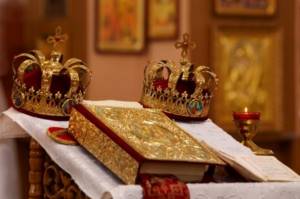
Wedding accessories
A powerful prayer to read before the wedding
no comments
Orthodox prayer should permeate the entire life of a believer, not to mention important, significant events. Orthodox prayer before a wedding is an old Russian custom. For most people, their wedding day is one of the most important days in their lives, and all newlyweds, without exception, want this day to mark the beginning of a long and happy married life. On the wedding day, the Orthodox bride and groom must come to the church, where they pray at the Divine Liturgy with the rest of the parishioners, confess and partake of the Holy Mysteries of Christ. Church prayer before a wedding is very important; it prepares the newlyweds for the great sacrament of marriage.
You need to pray before the wedding not only in the temple, but also at home. It’s good to read prayers and akathists the night before the icons of Christ, the Mother of God and the saints. In addition to the undoubted spiritual benefits, these prayers will calm you down on the eve of such an exciting day.
Which saints do they pray to before a wedding?
According to Russian tradition, on the eve of the wedding, brides pray in front of the icons of the Mother of God of Kazan, Vladimir, Feodorovskaya, Tenderness, Tikhvinskaya, Unfading Flower, Kozelshchanskaya. The grooms stand in front of the icons of Christ the Pantocrator. Before the wedding, you can also pray for well-being in marriage to Saints Nicholas the Pleasant, Paraskeva Pyatnitsa, Peter and Fevronia of Murom, Ksenia of Petersburg, Matrona of Moscow, Adrian and Natalya. These saints are also prayed to throughout their married life, so that husband and wife live in peace, so that there is no discord between them.
Do not forget to pray to your saints and guardian angels before the wedding, asking them for help in arranging married life, in overcoming temptations and sorrows, which, unfortunately, often arise on a common path. In Orthodox prayer before marriage, you can ask for childbirth, a common hearth, and an increase in love for each other. Do not hesitate to tell God and the saints about your needs and open your heart to them, because only in this way will they be able to hear you and help you.
Parental prayer before the wedding
Of course, their parents should not ignore the prayer support of the young. Maternal and paternal prayer before the wedding are just as important as the prayers of the young, because experienced parents better understand that married life is a joint feat of patience and love, and they know exactly what to ask God for their children. On the wedding day, in the morning, it is good for parents and their children to read the morning prayer rule, asking God for blessings for the day.
Orthodox text of prayer before the wedding
Lord our God, in Thy saving sight, who was vouchsafed in Cana of Galilee to show an honest marriage by Thy coming, Thy servants (names) Himself, who now deigned to unite with each other, preserve them in peace and unanimity: show their honest marriage, keep their undefiled bed, keep their undefiled Bless the cohabitation and make me worthy to achieve greatness in old age, doing Your commandments with a pure heart. For You are our God, the God of mercy and salvation, and we send up glory to You, with Your beginningless Father, Your All-Holy and Good and Life-giving Spirit, now and ever and unto ages of ages. Amen.
Read the text of the Orthodox prayer for love and happiness in the family
“Don’t be afraid, little flock! “I am with you and no one else is with you.”
Most Blessed Lady, take my family under Your protection. Instill in the hearts of my husband and our children peace, love and non-questioning of all that is good; Do not allow anyone from my family to experience separation and difficult parting, to premature and sudden death without repentance.
And save our house and all of us living in it from fiery ignition, thieves' attacks, every evil of the situation, various types of insurance and devilish obsession.
Yes, we too, collectively and separately, openly and secretly, will glorify Your Holy Name always, now and ever, and forever and ever. Amen.
Most Holy Theotokos, save us!
Listen to the wedding prayer on video
Sacrament of the Church - wedding
After the betrothal, with lit candles as a symbol of the Sacrament, the newlyweds move to the middle of the temple, following the priest. The priest offers incense to the Creator with the help of a censer, showing that in this way sincere fulfillment of the commandments of the Lord will be pleasing to the Creator.
The singers sing a psalm.
Psalm 127
Song of Ascension.
Blessed is everyone who fears the Lord and walks in His ways!
You will eat from the labor of your hands: blessed are you, and good to you!
Your wife is like a fruitful vine in your house; Your sons are like olive branches around your table:
so will the man who fears the Lord be blessed!
The Lord will bless you from Zion, and you will see the prosperity of Jerusalem all the days of your life;
You will see your sons' sons. Peace on Israel!
Between the lectern with the Gospel, cross and crowns laid out on it and the wedding couple, a cloth or towel is spread.
Before standing on the platform, the bride and groom once again confirm their decision to accept the wedding of their own free will, without any coercion. At the same time, emphasizing that none of them is bound by the promise of marriage with third parties.
The priest appeals to those present at the Sacrament to report facts that impede this union.
For in the future, all obstacles to marriage should be forgotten if they were not voiced before the blessing ceremony.
After this, the getting married couple stands on a towel laid under their feet. There is a sign that whoever stands on the board first will be the head of the house. Everyone present watches these actions with bated breath.
The priest speaks to the groom, asking whether, out of good will, sincere desire, he wants to marry the girl standing in front of him.
After a positive answer, the young man is obliged to confirm that he is not engaged to any other girl and is not bound by any promises to her.
The same questions are asked of the bride, clarifying whether she is going down the aisle under duress and is not promised to another man.
A mutually positive decision is not yet a union sanctified by God. For now, this decision may be the basis for concluding an official marriage in government bodies.
The sacrament of consecration of the new family before the Creator is performed over the officially registered newlyweds, the wedding ceremony begins, litanies are sounded, petitions for well-being, both spiritual and physical, for the newly born family.
Next, the priest reads three prayers.
The first prayer is filled with a request to Jesus Christ to bless the newlyweds with love for each other, long life, children and the purity of the marital bed. The priest asks for a blessing for the abundance in the house to be greater than the dew in the field, so that there will be everything in it, from grain to oil, allowing it to be shared with people in need.
“Bless this marriage: and give to Your servants a peaceful life, long life, love for each other in a union of peace, a long-lived seed, an unfading crown of glory; make them worthy to see the children of their children, keep their bed unblamed. And grant them from the dew of heaven from above, and from the fatness of the earth; Fill their houses with wheat, wine and oil, and every good thing, so that they share the excess with those in need, and grant to those who are now with us everything necessary for salvation.”
In the second prayer, an appeal to the Holy Trinity should be granted:
- children are like grains on an ear;
- abundance, like grapes on a vine;
- long life to see grandchildren.
“Give them the fruit of the womb, good children, like-mindedness in their souls, exalt them like the cedars of Lebanon, like a vine with beautiful branches, give them a spiked seed, so that, having contentment in everything, they may abound for every good deed that is pleasing to You. And may they see sons from their sons, like the young shoots of an olive tree, around their trunk, and having pleased You, may they shine like lights in the sky in You, our Lord.”
For the third time, a request is made to the Triune God to bless the young as heirs of Adam and Eve, created in the image and likeness of God, to create from them one spiritual flesh and to bless the womb of the wife, bestowing much fruit.
In reverence for the Great Creator, the union of a new couple in Heaven is sanctified and sealed by the Almighty himself.
The time has come for the main wedding ceremony - putting on the crown.
The priest takes the crown, baptizes the young man three times, giving him the image of Jesus Christ, located in front of the crown, to kiss and saying that the servant of God (name) is being married to the servant of God (name) in the Name of the Father, Son and Holy Spirit.
The same act is performed on the bride, only for the kissing she is offered to kiss the image of the Blessed Virgin Mary.
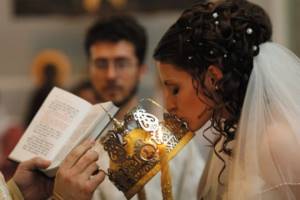
Wedding
Covered with the blessing of crowns, the couple awaits God's blessing as they stand before the face of the Almighty.
The most exciting and solemn moment of the entire Sacrament comes, when the priest, in the name of God, crowns the newlyweds, proclaiming blessings three times.
All those present must sincerely and reverently repeat the words of the priest within themselves, asking the Creator to bless the new family.
The priest seals God's blessing, proclaiming the birth of a new small church. Now it is a cell of a single Church, an indestructible church union. (Matthew 19:6)
At the conclusion of the wedding, the letter of the Apostle Paul to Christians in Ephesus is read, in which he says that a husband and wife are like Jesus and the Church. The husband is obliged to take care of his wife as if he were his own body; the wife’s task is to be submissive to her husband who loves her. (Eph. 5:20-33)
In his first letter to the Church of Corinth, the apostle left recommendations for the couple on behavior in the family to achieve complete harmony. (1 Cor.7:4).
The prayer “Our Father” is read, which the Savior left as a model of appeal to the Creator.
After this, the young couple drinks wine from a common cup, which brings joy, like the wedding at Cana, where Jesus turned water into wine.
The priest connects the right hands of the bride and groom with the help of an stole and covers it with his palm. This action symbolizes the transfer of the wife by the Church, uniting the couple in the name of Jesus Christ.
Taking the young people by the right hands, the priest walks around the lectern three times, performing troparia. Walking in a circle is a prophecy of eternal, never-ending earthly life for a new generation.
After removing the crowns and kissing the icons, the priest reads a few more prayers, after which the newlyweds kiss each other.
The sacrament of a wedding - how does the ceremony take place?
The second part of the sacrament of marriage begins with the bride and groom entering the middle of the temple with candles in their hands, as if carrying the spiritual light of the sacrament. In front of them is a priest with a censer, which symbolizes the importance of following the path of the commandments and offering up their good deeds as incense to the Lord.
The choir welcomes the couple by singing Psalm 127.
- Next, the couple stands on a white towel spread out in front of the lectern : both, in the face of God and the Church, confirm their free will, as well as the absence in their past (note - on each side!) of promises of marriage with another person. The priest asks these traditional questions to the bride and groom in turn.
- Confirmation of the voluntary and inviolable desire to marry cements the natural marriage , which is now considered consummated. Only after this does the sacrament of marriage begin.
- The wedding ceremony begins with the declaration of the couple's participation in the Kingdom of God and three lengthy prayers - to Jesus Christ and to the Triune God. After which the priest signs (in turn) the bride and groom with a crown in the shape of a cross, “crowning the servant of God...”, and then “crowning the servant of God...”. The groom must kiss the image of the Savior on his crown, the bride must kiss the image of the Mother of God that adorns her crown.
- Now the most important moment of the wedding comes for the bride and groom wearing crowns , when with the words “Lord our God, crown them with glory and honor!” the priest, as a link between people and God, blesses the couple three times, reading a prayer three times.
- The blessing of marriage by the Church symbolizes the eternity of the new Christian union, its indissolubility.
- Afterwards there is a reading of the Epistle to the Ephesians by St. Apostle Paul , and then the Gospel of John about the blessing and sanctification of the marriage union. Then the priest pronounces a petition for the newlyweds and a prayer for peace in the new family, honesty of marriage, integrity of cohabitation and life together according to the commandments until old age.
- After “And grant us, O Master...” everyone reads the prayer “Our Father” (it should be learned in advance if you did not know it by heart before preparing for the wedding). This prayer on the lips of a married couple symbolizes the determination to do the will of the Lord on earth through their family, to be devoted and submissive to the Lord. As a sign of this, the husband and wife bow their heads under their crowns.
- They bring the “cup of fellowship” with Cahors , and the priest blesses it and serves it as a sign of joy, offering to drink wine three times, first to the head of the new family, and then to his wife. They drink wine in 3 tiny sips as a sign of their inseparable existence from now on.
- Now the priest must connect the right hands of the newlyweds, cover them with stole (note - a long ribbon on the priest’s neck) and place his palm on top, as a symbol of the husband receiving his wife from the Church itself, which in Christ has united these two forever.
- According to tradition, the couple is led around the lectern three times : on the first circle they sing “Isaiah, rejoice...”, on the second circle they sing the troparion “Holy Martyr,” and on the third they glorify Christ. This walk symbolizes the eternal procession that begins from this day for the couple - hand in hand, with a common cross (the hardships of life) for two.
- The couple's crowns are removed , and the priest welcomes the new Christian family with solemn words. Then he reads two prayers of petition, during which the husband and wife bow their heads, and after finishing they seal pure mutual love with a chaste kiss.
- Now, according to tradition, married spouses are led to the royal doors : here the head of the family must kiss the icon of the Savior, and his wife - the image of the Mother of God, after which they change places and again kiss the Images (only in reverse). Here they kiss the cross, which the priest offers, and receive from the minister of the Church 2 icons, which can now be kept as a family heirloom and the main amulets of the family, and passed on to future generations.
After the wedding, candles are kept in the icon case at home. And after the death of the last spouse, these candles (according to the old Russian custom) are placed in the coffin, both of them.
In what cases is a church marriage unacceptable?
According to church canons, not every marriage can be blessed in church. There are several contraindications for weddings.
- Some of the young people have already received the rite of the Sacrament three times. The Church does not solemnize fourth and subsequent marriages permitted by civil law.
- The couple or one of the members of the future family considers themselves atheists.
- Unbaptized people cannot walk down the aisle, but they can be baptized as adults, immediately before the ceremony.
- People who have not officially broken ties in a previous marriage, both according to civil and Christian laws, cannot receive a blessing for further family life.
- Blood relatives of the bride and groom cannot create a Christian family.
On what days does the wedding not take place?
The canonical rules clearly define the days when blessing ceremonies are not performed:
- throughout all the days of fasting, and there are four of them;
- seven days after Easter;
- 20 days from Christmas to Epiphany;
- on Tuesdays, Thursdays, Saturdays;
- before the great temple holidays;
- for the day and on the feast itself of the Beheading of John the Baptist and the Exaltation of the Cross of the Lord.
Advice! The date of the future wedding should be discussed in advance with your spiritual mentor.
When there is no wedding
You can't always get married. This should be taken into account when planning your wedding date. There are days and periods of the year when church weddings do not take place:
- Tuesday, Thursday, Saturday – all year round.
- On the eve of the twelve, temple and great holidays.
- During all four multi-day fasts.
- From Christmas (January 7) to Epiphany (January 19).
- During Maslenitsa.
- During Easter week.
- On the days and on the eve of the Beheading of John the Baptist (September 11) and the Exaltation of the Cross of the Lord (September 27).
It is better to get married not on the eve of fasting (on the last day when people get married), but after fasting, or at least two or three weeks before the start of fasting. This, of course, is not a church decree, but advice, a wish for those planning to get married.
